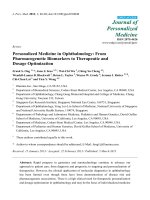Pediatric emergency medicine trisk 627
Bạn đang xem bản rút gọn của tài liệu. Xem và tải ngay bản đầy đủ của tài liệu tại đây (224.62 KB, 4 trang )
FIGURE 96.23 A: Caput succedaneum involves the collection of serous fluid and often crosses
the suture line. B: Cephalohematoma involves the collection of blood and does not cross the
suture line. (Reprinted with permission from Ricci SS. Essentials of Maternity, Newborn, and
Women’s Health Nursing . 2nd ed. Philadelphia, PA: Lippincott Williams & Wilkins; 2008.)
Perinatal Birth Injuries to Head and Neck
Goals of Treatment
Trauma during labor and delivery can be related to maternal, fetal, and obstetric
factors. Traumatic deliveries occur as a result of prolonged labor, large fetus,
prematurity, and abnormal presentation, and as a result of assisted deliveries, for
example, vacuum extraction and forceps delivery. Although the majority of these
injuries are diagnosed prior to discharge from the newborn nursery and are selflimiting, some are serious and potentially lethal. The primary goals of
management should be to recognize benign injuries and differentiate them from
those caused by nonaccidental trauma and manage any acute crises, for example,
acute hemorrhagic shock.
CLINICAL PEARLS AND PITFALLS
Cephalohematomas are subperiosteal hemorrhages that do not cross
the suture lines. They should not be routinely incised or aspirated.
Subgaleal hemorrhage can lead to hypovolemic shock and can present
days after birth.
Traumatic facial nerve palsy is unilateral and will usually recover
spontaneously.
Neck masses in a neonate need evaluation for airway proximity and
compression.
Cephalohematoma
Cephalohematoma ( Fig. 96.17 ) is a subperiosteal hemorrhage occurring
commonly over a parietal bone, distinguished from a caput succedaneum by the
fact that the swelling never crosses suture lines ( Fig. 96.23 ). It occurs in 0.4% to
2.5% of live births due to rupture of blood vessels traversing the skull to the
periosteum. The overlying skin is intact with no petechiae or hemorrhage.
Cephalohematomas often feel fluctuant and may be bordered by elevated ridges
of surrounding tissue, giving a false sensation of a skull depression. They may be
associated with intracranial hemorrhage and 5.4% are also associated with linear
skull fractures. Cephalohematomas often become prominent after the immediate
newborn period when scalp edema subsides. Most commonly, a
cephalohematoma is unilateral, but it can be bilateral. They resolve slowly over 4
to 6 weeks, possibly with calcification and the formation of a hard bump on the
scalp that may be a source of great concern to parents. Occasional complications
resulting from the breakdown and resorption of large hematomas are
hyperbilirubinemia or anemia. No therapy is required for uncomplicated lesions.
Routine incision or aspiration of a cephalohematoma is contraindicated due to the
high risk of introducing infection. Rare complications of localized infection of
cephalohematoma include osteomyelitis, meningitis, and venous sinus
thrombosis.
Subgaleal Hemorrhage
Subgaleal hemorrhage (SGH) refers to hemorrhage into the soft tissue space
between the galea aponeurotica and the periosteum ( Fig. 96.24 ). Rupture of
emissary veins within this extensive space results in hemorrhage across the whole
cranial vault from the orbital ridges to the nape of the neck. This space can hold
up to 260 mL of blood (which could exceed the entire blood volume of a fullterm baby) and thus bleeding here can result in hemorrhagic shock. Newborns
with SGH have a history of difficult instrumental delivery using vacuum suction
or forceps (64% to 91%). Other predisposing factors include coagulopathies
(hemophilia and Christmas disease), vitamin K deficiency, macrosomia, and
dystocia.
FIGURE 96.24 Subgaleal hemorrhage and normal caput, cephalohematoma, and intracranial
hemorrhage. (Reprinted with permission from Gibbs RS, Karlan BY, Haney AF, et al.
Danforth’s Obstetrics and Gynecology . 10th ed. Philadelphia, PA: Lippincott Williams &
Wilkins; 2008.)
FIGURE 96.25 Subgaleal hematoma. Discoloration and swelling extends across suture lines
onto the neck, even onto the ear, causing protuberance of the pinna. (Reprinted with permission
from Fletcher MA. Physical Diagnosis in Neonatology . Philadelphia, PA: Lippincott–Raven
Publishers; 1998:185.)
SGH develops insidiously and may not be apparent until several hours or even
days after delivery and until blood loss is extensive. Discoloration of the scalp
occurs very late because blood collects deep beneath the aponeurotic layer. Pallor
and weakness may be the only early symptoms of SGH and may be accompanied
by a rising pulse rate and increasing respiratory rate. Diffuse pitting swelling of
the scalp or a fluctuating mass extending from the occiput posteriorly to
ecchymotic orbits anteriorly and displacing the ears is suggestive ( Fig. 96.25 ).
Hypoperfusion and falling hematocrit in a child who has undergone a difficult
extraction should alert the clinician to the possibility of SGH even in the absence
of a fluctuant mass. CT scan will demonstrate presence of blood in subgaleal
space and rule out associated fractures or intracranial hemorrhages ( Fig. 96.26 ).
Patients with significant SGH may require emergency-packed RBC transfusion,
and fresh frozen plasma if PTT is prolonged. Concomitant intravenous
administration of vitamin K can be performed. Surgical drainage can be
considered as a last resort. SGH with shock has a high mortality rate of 22% to
25%.
Facial Nerve Palsy









